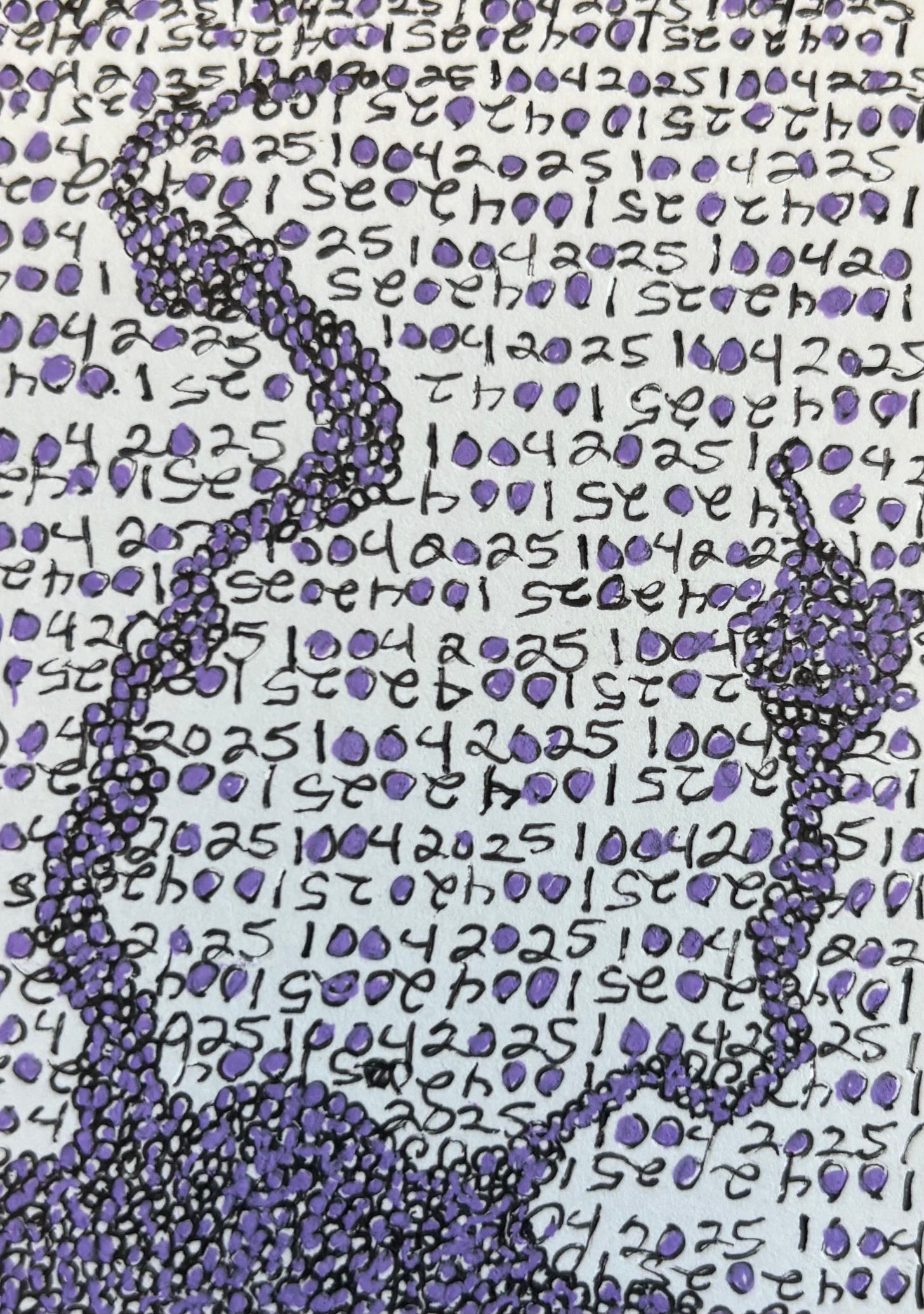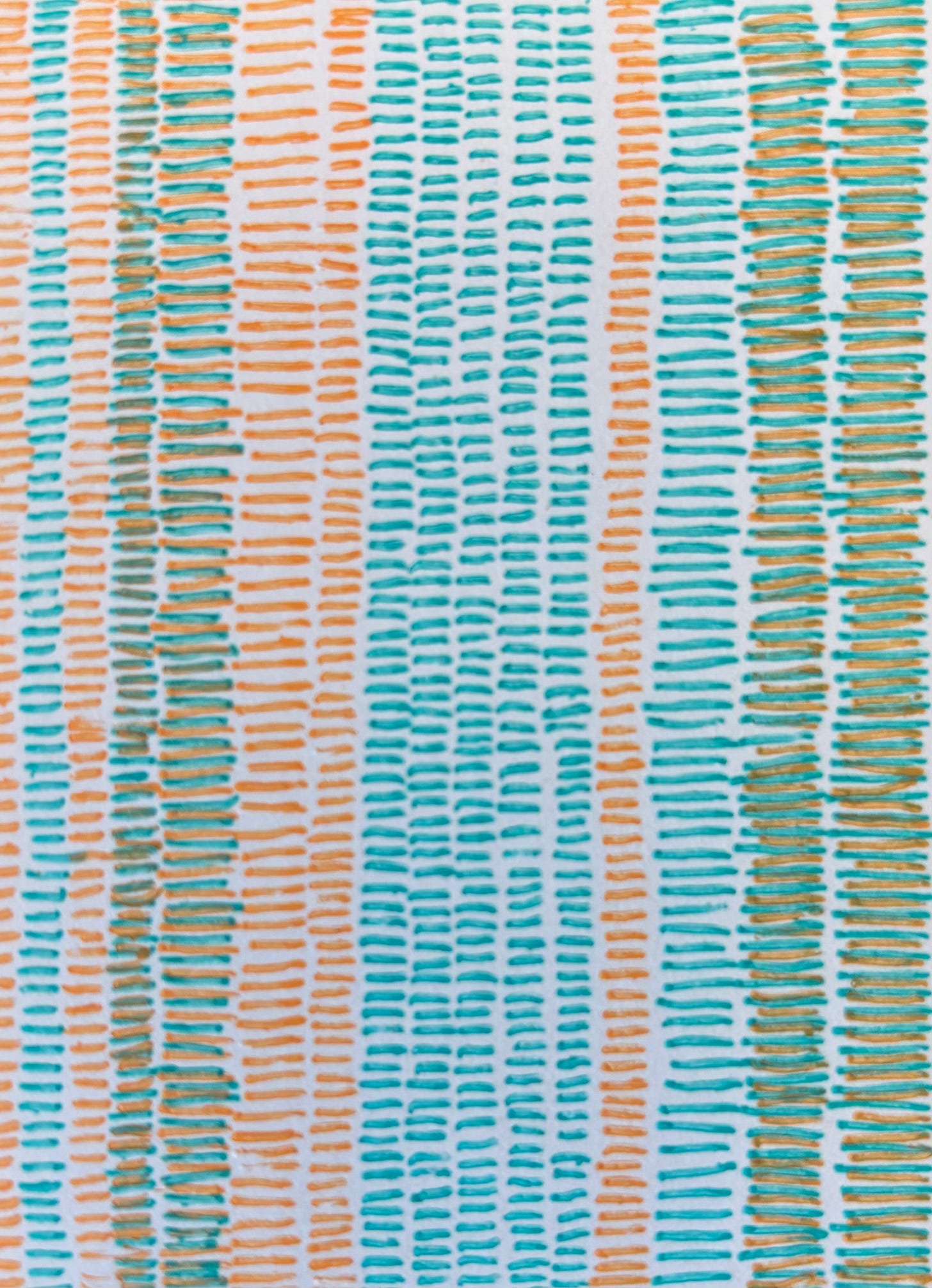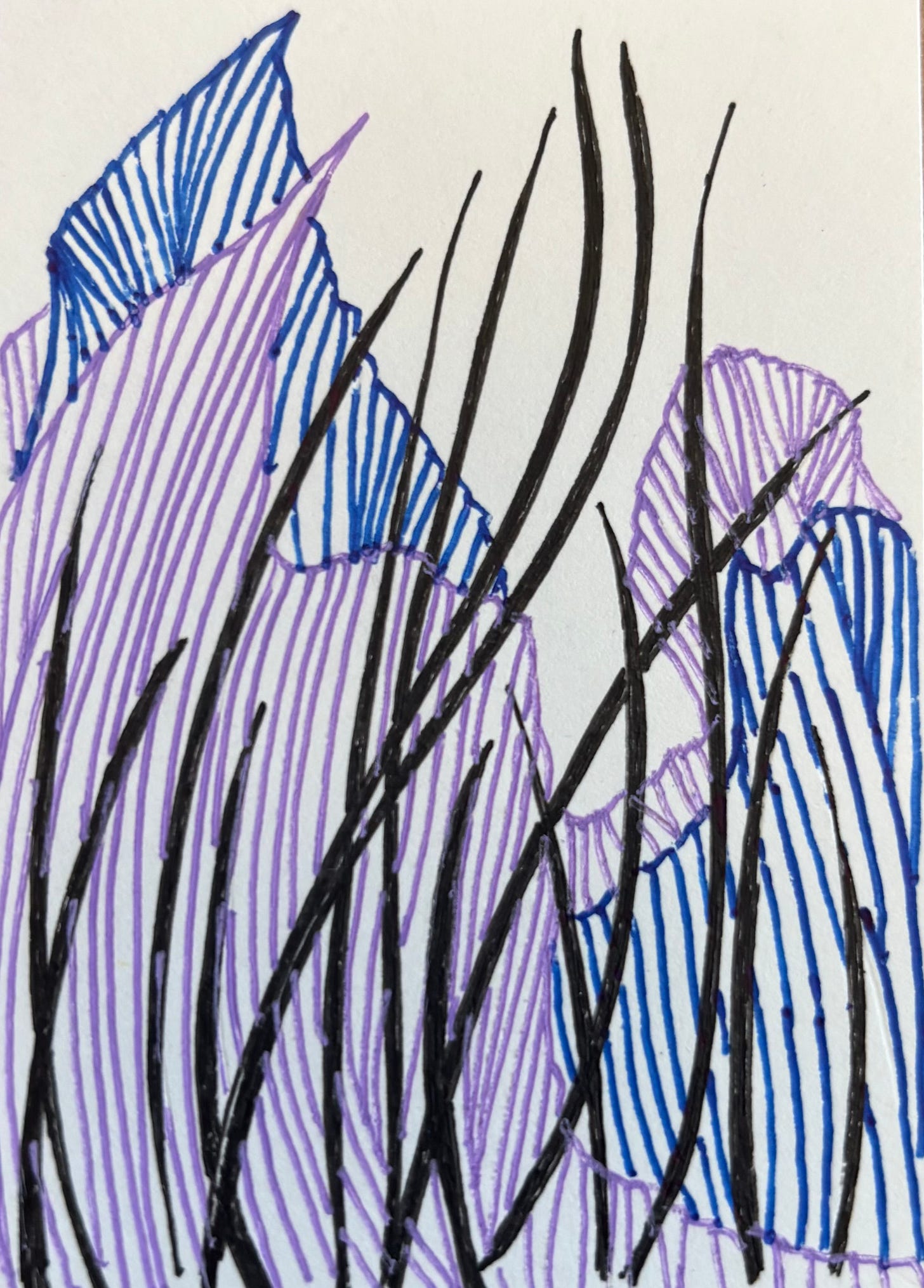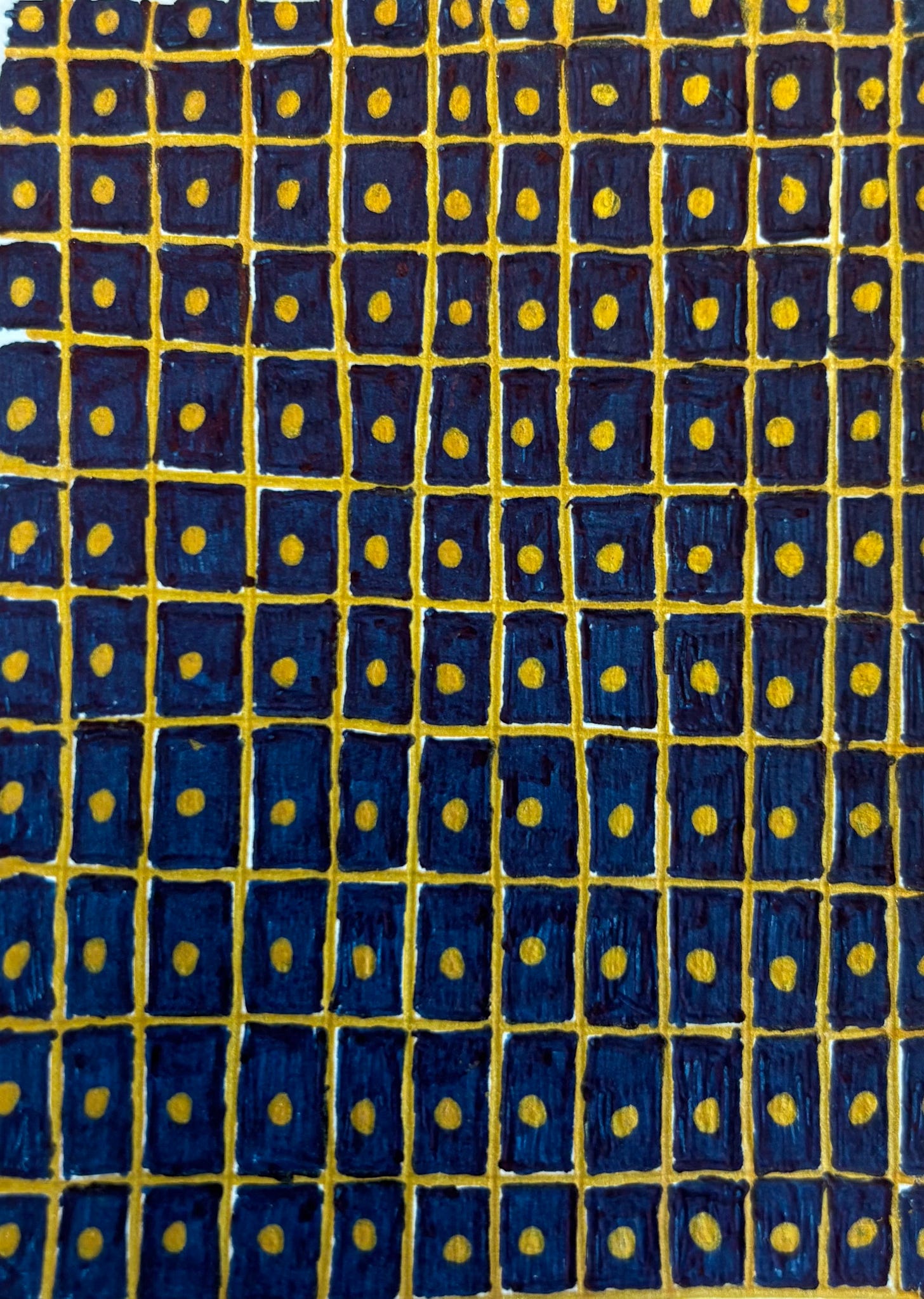The Work Begins the Moment I Stop Waiting to Feel Ready
Finding rhythm, breath, and meaning in the smallest acts of creation
I didn’t plan to make art outside. It just happened — one small act after another, until I realized this quiet backyard had become both my studio and my teacher.
When the Pens Stop Working
It started with a stack of 2.5 x 3.5-inch cards and a handful of pens that still worked.
My better pens—the ones I use for larger drawings—were all clogged again. I’d tried to clean them with the ultrasonic machine, and a few recovered for a while, but then they seized up once more.
That’s how it goes. So I picked up what was available and began making patterns in gold and blue, little grids and rectangles that shimmered unevenly in the morning light. They weren’t the projects I most wanted to do, but they were what I could do, and that had to be enough.
For the past week, I’ve been working outside as I recover from COVID.
I didn’t want to risk exposing my parents, so I carried my supplies out to the patio table—a long steel dining table meant for family gatherings, now covered with pots of rosemary, succulents, and herbs.
The air felt good that first morning, a kind of medicinal freshness that only comes after days of being cooped up inside. From my seat in the shade, I could look across the yard: roses climbing the far wall, the soft hum of birds moving from feeder to feeder, and the ridgeline of the nearby mountain glowing in morning light.
The Language of Birds and Coyotes
When I sit here, I usually hear birds all day long—mockingbirds, finches, jays, quail, pigeons, and the hawk who clears all others out immediately. There’s a feeder near the fence, and they take turns as if following an unspoken schedule.
I’ve come to know their hierarchy—the bossy ones who swoop in first, the smaller ones who wait in the shadows until it’s safe.
Sometimes I hear a plane overhead, or the neighbor’s dogs barking in bursts, or nothing at all but wind turning the metal wind sculptures above the garden. The shade cools the air until late afternoon, when the sun settles behind me and the warmth reaches my back for about an hour before it slides away again.
Coyotes wander the hillside, too. I see them when I’m out walking early, or sometimes just beyond the fence while I’m sitting here drawing. They don’t simply howl the way people imagine—they talk.
Their sounds are more like short, strange syllables, a kind of staccato vocabulary. I’ve grown used to it. They look at me sometimes and then disappear behind a neighbor’s house, tails thick and feathery as dust clouds.
I’ve even seen a bobcat once, quick and quiet. I like knowing that I’m not alone out here—that the land is still alive around me, full of movement and hidden languages.
The patio is made of concrete, cool underfoot, with a lawn beyond. My mom tends the plants constantly. She trims, waters, rearranges. The air always smells faintly of soil and mint. I listen to music or a podcast while I draw, but sometimes I pull the earbuds out just to hear the sound of the pen scratching on paper.
I can tell when the ink is running low by feel alone. These small rhythms—the glide of rapidograph pens, the pause between lines, the breath I hold when I draw curves—keep me present. They’re my metronome.
The Practice of Small Things
What’s funny is that I never planned to work this small.
Yes, I’ve done it before, but I’m only doing it now because the pens I really want to use are clogged. That’s how it often goes with art and with life: I don’t always choose the project; the project chooses me.
I start something because it’s the only thing I can start, and in that limitation, something opens. These 2.5 x 3.5-inch drawings are their own kind of meditation—tiny, demanding, impossible to fake. Every line matters. Every mistake shows. And maybe that’s the point.
As I draw, I imagine what might come next. I picture turning these patterns into linocut prints, maybe on 5x7 paper, carving by hand, and printing outside.
I can see myself setting up the plastic table, or laying a sheet of plywood across the metal one, and using clothespins to hang the prints to dry. It would be easy to do, really—simple, physical work. The wind might be an issue, but even that feels like part of the process. Each print would move slightly in the breeze, catching light differently, never quite the same twice.
And this—this kind of imagining—is how new projects are born. One idea leads to another, usually out of necessity. The creative impulse doesn’t wait for perfect conditions. It begins wherever I am, with whatever still works.
The same is true of rebuilding a life, or starting over, or trying again when everything feels broken. It’s true of recovery—physical, emotional, and financial.
The creative act is the act of recovery.
Work, Money, and the Art of Survival
Still, there’s a practical side to all this. Art alone doesn’t pay the bills, not yet. The cost of living in California is steep, and supplementing my income isn’t optional.
I need to find remote work that allows me to maintain this rhythm—drawing, writing, walking, and taking care of my parents. Ideally, I wouldn’t be spending hours scrolling through job listings or rewriting resumes. But I’m learning that this search, too, is part of the same practice.
It requires patience, persistence, and faith in the slow accumulation of effort.
The way I work now, my writing, art, and job search all overlap. They feed each other. When I write about this process, it becomes part of my illustrated memoir, Lines on the Spectrum.
When I teach or develop my course, Art as Spiritual Practice, it grows from the same soil—the same questions about presence, vulnerability, and the discipline of showing up. The work of living and the work of creating are one and the same.
There’s a freedom that comes with accepting that nothing will ever feel quite ready. The pens clog, the light shifts, the world interrupts. And yet, something still moves through me when I sit down and begin.
Each small act—drawing a grid, unclogging a pen, setting up a table outside—becomes a declaration that I’m still here.
That I’m paying attention.
The Moment I Stop Waiting
Maybe that’s why the coyotes fascinate me so much. They live between worlds—close enough to suburbia to hear leaf blowers and car alarms, wild enough to vanish into silence in an instant. Their language is messy and urgent and alive.
I think my art is, too. It’s not about perfection; it’s about persistence, about speaking in the vocabulary I have, even if it’s strange and fragmented.
So I sit at this table, surrounded by plants and wind and sunlight, the smell of mint and soil, the distant conversation of coyotes.
The drawings pile up.
The ideas multiply.
I realize that the work doesn’t begin when I have the right tools or the perfect plan—it begins the moment I stop waiting to feel ready.
Aspie Art Journey is where I trace the intersections of art, discipline, and daily life — a record of how creativity and survival overlap. Each post is a step toward clarity, connection, and something larger than myself.







